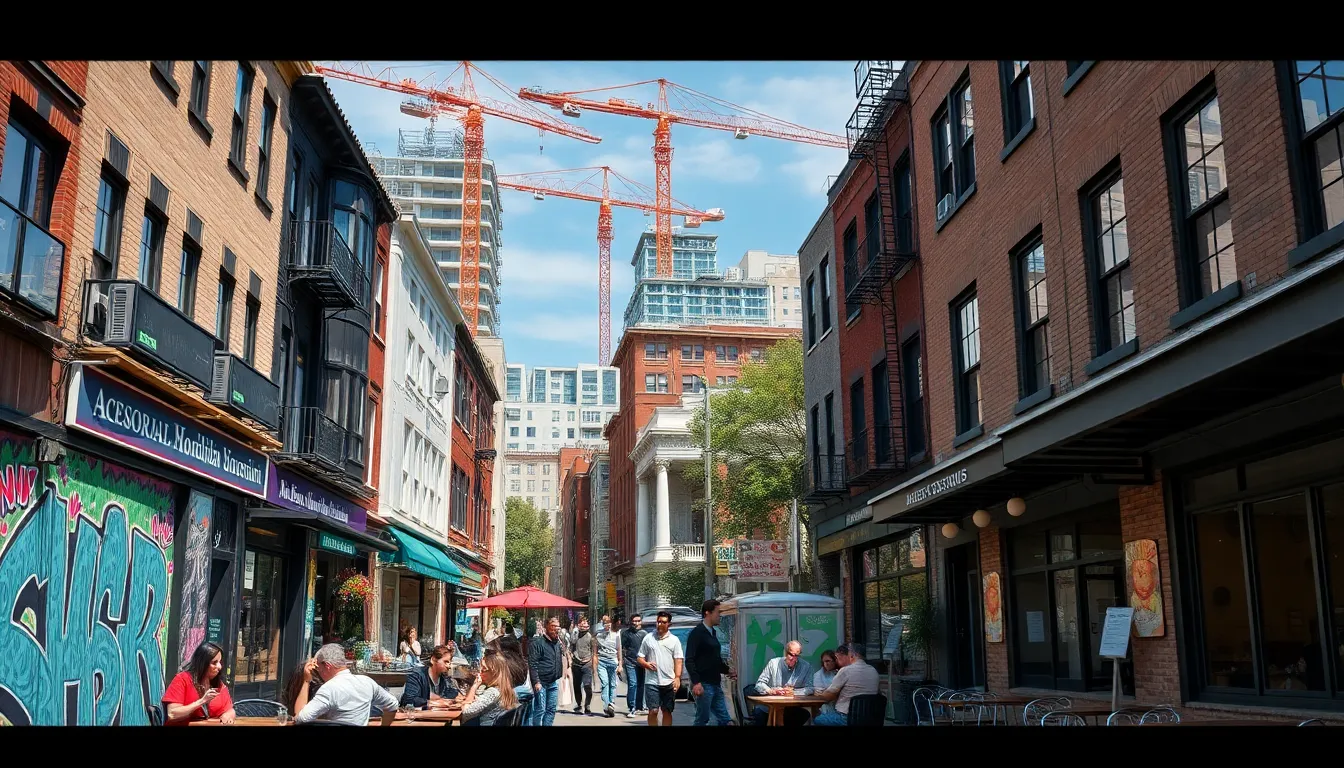Gentrification is like that uninvited guest who shows up at your party, eats all your snacks, and then redecorates your living room. As neighborhoods evolve, long-time residents often find themselves facing the uncomfortable reality of displacement. Understanding gentrification displacement rights isn’t just a legal matter; it’s a crucial step in ensuring that communities can thrive without losing their identity.
Navigating the complexities of displacement can feel like trying to solve a Rubik’s Cube blindfolded. But fear not! With the right knowledge, residents can arm themselves with the tools to advocate for their rights. This article dives into the nitty-gritty of gentrification displacement rights, shedding light on how individuals can stand up against the tide of change while keeping their homes and communities intact.
Table of Contents
ToggleUnderstanding Gentrification Displacement Rights
Gentrification displacement rights refer to the legal protections available to residents facing eviction due to neighborhood changes. These rights aim to safeguard long-term residents from being forced out of their homes as property values rise and new developments occur. Communities often find themselves affected by rapidly increasing rents and property taxes.
Knowledge about local laws is crucial. Many jurisdictions have ordinances designed to prevent unjust evictions and promote tenant stability. These laws can include rent control measures, anti-displacement policies, and relocation assistance programs. Residents need to identify specific city regulations that may provide additional protection against displacement.
Advocacy plays a vital role. Individuals and groups can work together to raise awareness about displacement issues within their communities. Organizing workshops and meetings enables residents to understand their rights and prepare for potential challenges. Support networks can also provide legal assistance to those at risk of losing their homes.
Additionally, community engagement is essential. Residents must communicate their needs to local government representatives. By voicing concerns, they can influence policy changes that address housing affordability and gentrification impacts.
Lastly, resources are available. Non-profits and legal aid organizations often offer guidance on tenant rights and protection from displacement. Utilizing these resources ensures residents have the tools needed to advocate effectively for their communities. Staying informed about gentrification and displacement rights empowers residents to protect their homes and maintain their neighborhoods’ identity.
Causes of Gentrification
Gentrification results from various interconnected factors that reshape neighborhoods. Understanding these causes helps clarify the displacement residents face.
Economic Factors
Economic growth drives gentrification, as rising property values attract investors. Increased demand for housing often leads to renovation of older buildings. This renovation raises rental prices, making it financially challenging for long-time residents to stay. Job growth in urban areas also attracts new residents who can afford higher rents. Property investment becomes appealing, with developers seeing potential for profit. Significant infrastructural improvements, such as transit upgrades or commercial development, further accelerate these economic changes.
Social Factors
Social dynamics also contribute to gentrification. Changes in demographic trends, like an influx of young professionals, often alter neighborhood characteristics. This shift can diminish the presence of long-standing community members. Cultural amenities, such as trendy restaurants and shops, appeal to newcomers and enhance neighborhood desirability. Increased attention from local media can illuminate areas perceived as up-and-coming, further attracting new residents. Fear of losing cultural identity often arises among existing communities as these shifts unfold.
Impact of Gentrification on Communities
Gentrification significantly alters the fabric of communities, impacting residents’ rights and their quality of life. Displacement frequently occurs, fundamentally reshaping neighborhoods.
Displacement of Low-Income Residents
Low-income residents often face the brunt of gentrification. Rising property values and increased rental costs push them out of their neighborhoods. Many struggle with financial pressures, which exacerbate their vulnerability to eviction. Legal protections may exist, yet residents might not know their rights or available resources. Advocacy groups strive to inform and support these individuals, assisting them in navigating the often-complex landscape of tenant laws. Local organizations frequently provide workshops designed to empower residents, ensuring they understand their displacement rights. The voices of these communities must be amplified to effect meaningful change against unjust evictions.
Changes in Neighborhood Dynamics
Changes in neighborhood dynamics can occur swiftly after gentrification begins. New businesses often emerge, catering to higher-income residents and attracting different demographics. This influx can lead to a cultural shift, where long-standing traditions and community ties weaken. Residents may notice less representation of their cultural heritage in local establishments. Youth engagement in community events often declines as younger populations prioritize new venues that align with their interests. City services may also adapt to suit the needs of newcomers, leaving existing residents overlooked. As these dynamics evolve, resistance from long-time residents becomes critical to maintaining neighborhood identity and community cohesion.
Legal Framework Surrounding Displacement Rights
Understanding the legal framework surrounding displacement rights is essential for residents facing gentrification. It includes various laws and regulations designed to protect tenants from unjust evictions.
Tenant Protection Laws
Tenant protection laws vary by state and city, offering safeguards against displacement. These laws often include rent control measures that limit how much landlords can increase rent annually, thus helping long-term residents afford their housing. Additionally, some jurisdictions enforce “just cause” eviction policies, requiring landlords to provide valid reasons for evicting tenants. Moreover, anti-retaliation laws protect residents from eviction or harassment when they assert their rights. Advocacy organizations frequently assist residents in navigating these laws, promoting awareness of available protections.
Zoning and Land Use Regulations
Zoning and land use regulations play a significant role in shaping neighborhoods. Local governments implement these regulations to guide development and maintain community character. Zones dictate what types of buildings can be constructed and where, influencing property values and rental markets. Inclusionary zoning policies may require new developments to include affordable housing units, ensuring long-time residents have options within their neighborhoods. Regulations can also preserve cultural heritage sites and historic districts by preventing inappropriate redevelopment. Understanding these regulations empowers residents to engage in local planning processes, advocating for equitable development.
Advocacy and Community Response
Advocacy serves as a pivotal force in combating gentrification displacement. Community members actively engage in initiatives that raise awareness about displacement rights and promote housing stability.
Grassroots Movements
Grassroots movements often emerge as powerful advocates for long-time residents. Initiatives like local tenant associations unite community members against unjust evictions. Residents participate in organized rallies and educational forums to connect with one another and share experiences. Collectively, they become a vocal presence in local government meetings, pushing for changes that prioritize housing affordability. Such movements can harness social media to amplify their message, reaching broader audiences and attracting allies.
Policy Changes and Reforms
Policy changes can significantly influence the landscape of gentrification displacement. Advocacy groups collaborate with local governments to push for effective reforms like stringent rent control laws and stronger tenant protections. These groups gather data to demonstrate the urgent need for policies addressing housing security. When local councils understand the community’s needs, they can implement measures promoting equitable development and affordable housing options. Engaging with policymakers leads to the development of inclusive zoning laws that ensure new constructions include affordable units, preserving neighborhood diversity.
Conclusion
Understanding gentrification displacement rights is crucial for preserving community identity amidst rapid neighborhood changes. Long-time residents must recognize the legal protections available to them and actively engage with advocacy groups for support. By staying informed about local laws and participating in community initiatives, they can effectively combat unjust evictions and maintain their homes.
Collective action and grassroots movements empower residents to voice their concerns and influence local policies. As communities navigate the complexities of gentrification, the commitment to protect their rights and advocate for equitable development becomes essential. This proactive approach not only safeguards homes but also enriches the cultural fabric of neighborhoods.









